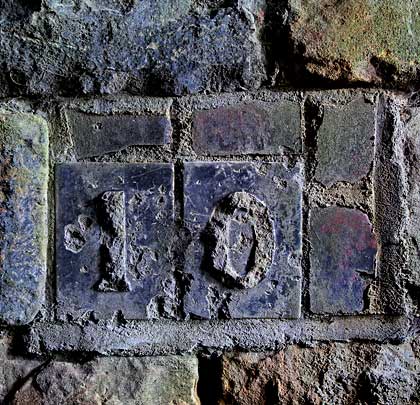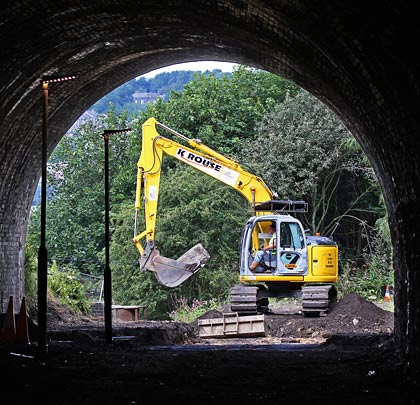Earlsheaton Tunnel
Earlsheaton Tunnel
























Coal and heavy industry enticed the Great Northern Railway into the heart of West Yorkshire but it didn’t make a connection with Dewsbury until May 1874. Parliamentary powers were granted in July 1871 for a branch into the town from the east, leaving the Batley-Ossett line at Runtings Lane Junction. The route descended on gradients as steep as 1:53, passing through a 179-yard tunnel at Earlsheaton.
Construction of the tunnel did not pass without incident. On 18th December 1872, heavy snowfall caused a landslide in the eastern approach cutting 20 yards from the entrance. This triggered the collapse of the tunnel’s timber formwork, entombing labourer James Smythe beneath the debris. His cries grew weaker over the half-hour that followed until silence prevailed and any hope of extricating him was finally extinguished.
In May 1873, a fall of rock within the tunnel claimed another life. But completion was marked with some ceremony later the same month when the keystone was inserted in the arch. The Great Northern laid a dinner on for the navvies at the Man & Saddle Hotel, during which it was announced that the line would be extended through to Bradford via a tunnel at Staincliffe. This plan however was not pursued; instead a northerly extension to Batley opened in April 1880, forming a 3½-mile loop line and bringing a consequential reduction in passenger services on the original single track route between Batley and Ossett. Dewsbury Central Station replaced the branch’s former terminus.
Curving to the north on a radius of around 31 chains, the tunnel features characteristic GN portals, built mostly in brick but with masonry voussoirs, corbels, string course and copings. At the western end, the land rises steeply, resulting in a short approach cutting with retaining walls extending parallel to the trackbed.
The lining comprises vertical side walls in sandstone to a height of around 7 feet, and a brick arch. There are no refuges or ventilation shafts. Tablets in the south wall acted as location markers for the lengthman’s inspection notes. Hangers were also attached to carry signalling cables.
The eastern approach cutting is both deeper and longer. The portal is similar in design to that at the west end, except the wing walls follow the line of the headwall.
The tunnel’s operational life was brought to a close on 15th February 1965 with the imminent closure of Old Roundwood Colliery. Since then, there has been little decline in the condition of the barrel, although penetrating ground water has resulted in localised loss of the outer blockwork skin. The central section is dry. A bulge has formed on the south spandrel of the eastern headwall; a sapling has taken root above the string course, pushing the parapet upwards.
The tunnel and its approaches were sold to Dewsbury Corporation in 1974 and the entrances were subsequently secured, preventing public access. However plans to create a foot and cycle route between Dewsbury and Ossett has resulted in works starting to carry out structural repairs and install lighting. Earthworks beyond the western end have been excavated to provide a gently graded link to Preston Street. It is hoped that the section of path through the tunnel will be opened by the end of 2012.








